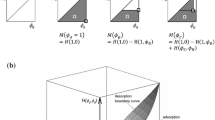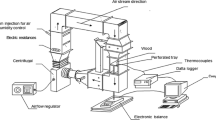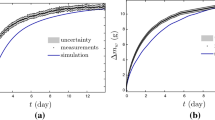Abstract
The scope of this paper is an experimental characterization of diffusion parameters for wood material. Based on a nonlinear mass transfer algorithm, the present study focuses on the need to capture experimental moisture profiles in the sample, along with its evolution in weighting during both the desorption and adsorption phases, especially when the moisture content of the samples is far from the equilibrium state inducing a great gradient between heart and exchange surfaces of specimen. These moisture profiles are derived by means of a gammadensimetry laboratory method based on the water adsorption of gamma rays. Determination of the diffusion parameters is obtained through optimizing a simulation by means of implementing the mass transfer kinetics into a finite difference method. Both the diffusion coefficient and convective exchange coefficient are deduced by considering a Nelder–Mead simplex inversion method. This work highlights the efficiency of the approach dedicated to uncoupling nonlinear diffusion in the cross sections from boundary conditions in terms of convective exchanges and equilibrium moisture. Scale effects and boundary conditions are also investigated herein.












Similar content being viewed by others
References
Colmars J, Dubois F, Gril J (2014) One-dimensional discrete formulation of a hygrolock model for wood hygromechanics. Mech Time Depend Mater 18(1):309–328
Da Rocha MC et al (2001) Moisture profile measurements of concrete samples in vertical water flow by gamma ray transmission method. Radiat Phys Chem 61(3-6):567–569
Da Silva WP, Da Silva LD, e Silva CDMPS, Nascimento PL (2011) Optimization and simulation of drying processes using diffusion models: application to wood drying using forced air at low temperature. Wood Sci Technol 45:787–800
Droin Josserand A, Vergnaud JM, Taverdet JL (1989) Modeling the process of moisture absorption in three dimensions by wood samples of various shapes: cubic, parallelepipedic. Wood Sci Technol 23(3):259–271
Dubois F, Petit C, Sauvat N, Peuchot B (2006) Diagnostic et comportement des ponts à ossature bois: application au pont de Merle (Diagnostics and behavior of timber bridges: study of the Merle’s timber bridge) (In French). Eur J Civ Eng 10(2):191–208
Dubois F, Husson JM, Sauvat N, Manfoumbi N (2012) Modeling of the viscoelastic mechano-sorptive behavior in wood. Mech Time-Depend Mater 16(4):439–460
Ferraz ESB, Aguiar O (1985) Gamma-ray attenuation technique for determining density and water content of wood samples. IPEF 30:9–12
Frandsen HL, Damkilde L, Svensson S (2007) A revised multi-Fickian moisture transport model to describe non-Fickian effects in wood. Holzforschung 61:563–572
Jakiela S, Bratasz L, Kozlowski R (2008) Numerical modeling of moisture movement and related stress filed in lime wood subjected to changing climate conditions. Wood Sci Technol 42(21):21–37
Kelley CT (1999) Iterative methods for optimization. Society for Industrial and Applied Mathematics, North Carolina State University, Raleigh, pp 135–141
Kouchade AC (2004) Détermination en routine de la diffusivité massique dans le bois par méthode inverse à partir de la mesure électrique en régime transitoire (Determination in routine of wood mass diffusivity by inverse method from electrical measurement in transient state), PhD Thesis, Engref, Nancy (in French)
Krabbenhoft K (2003) Moisture transport in wood: a study of physical-mathematical models and their numerical implementation. PhD Thesis, Department of Civil Engineering Technical University of Denmark, 2003
Krabbenhoft K, Damkilde L (2004) A model for non Fickian moisture transfer in wood. Mater Struct 37:615–622
Lagarias JC, Reeds JA, Wright MH, Wright PE (1998) Convergence properties of the Nelder-Mead simplex method in low dimensions. SIAM J Optim 9(1):112–147
Lasserre B (2000) Modélisation thermo-hygro-mécanique du comportement différé de poutres de structure en bois (Thermo-hygro-mechanical modeling of the different behavior of wooden structural beams) PhD Thesis, University of Bordeaux I (in French)
Liu JY, Simpson WT (1999) Inverse determination of diffusion coefficient for moisture diffusion in wood. In: Proceedings of 33rd ASME national heat transfer conference: heat and mass transfer in porous media, August 15–17, Albuquerque, New Mexico
Loulou L (2013) Durabilité de l’assemblage mixte bois-béton collé sous chargement hydrique (Durability of wood-concrete assembly subjected to relative humidity variations), PhD Thesis, University of Paris Est, France (in French)
Manfoumbi N (2012) Adaptation réglementaire de l’Eurocode 5 aux essences tropicales dans un climat tropical (Contribution to the adaptation of Eurocode 5 to tropical hardwoods in their environment). PhD Thesis, University of Limoges (in French)
Manfoumbi N, N’Guyen TA, Angellier N, Dubois F, Ulmet L, Sauvat N (2014) Experimental and numerical aspects in diffusion process characterization in tropical species. Eur J Environ Civ Eng 18(9):963–982
Merakeb S, Dubois F, Petit C, Sauvat N (2006) Couplage hydromécanique dans le processus de diffusion dans le bois (Hydromechanical coupling in the diffusion process in wood) (In French). Eur J Civ Eng 10(2):225–251
Merakeb S, Dubois F, Petit C (2009) Modeling of the sorption hysteresis for wood. Wood Sci Technol 43(7–8):575–589
Nedler JA (1965) Downhill simplex method. Comput J 7:308–313
Olek W, Perre P, Weres J (2011) Implementation of a relaxation equilibrium term in the convective boundary condition for a better representation of the transient bound water diffusion in wood. Wood Sci Technol 45:677–691
Olek W, Rémond R, Weres J, Perré P (2016) Non-Fickian moisture diffusion in thermally modified beech wood analyzed by the inverse method. Int J Therm Sci 109:291–298
Perre P, Degiovanni A (1990) Simulation par volumes finis des transferts couplés en milieux poreux anisotrope: séchage du bois à basse et haute température (Control-volume formulation of simultaneous transfers in anisotropic porous media: simulations of softwood drying at low and high temperature). Int J Heat Mass Transf 33(11):2463–2478 (in French)
Perre P, Turner IW (2008) A mesoscopic drying model applied to the growth rings of softwood: mesh generation and simulation results, Maderas. Cienca y tecnologia 10(3):251–274
Rozas C, Tomaselli I, Zanoelo EF (2009) Internal mass transfer coefficient during drying of softwood (Pinus elliottii Engelm.) boards. Wood Sci Technol 43:361–373
Villain G, Thierry M (2006) Gammadensimetry: a method to determine drying and carbonation profiles in concrete. ND&E Int 39(4):328–337
Zhou Q, Cai Y, Xu Y, Zhang X (2011) Determination of moisture diffusion coefficient of larch board with finite difference method. Bio Res 6(2):1196–1203
Author information
Authors and Affiliations
Corresponding author
Rights and permissions
About this article
Cite this article
Nguyen, T.A., Angellier, N., Caré, S. et al. Numerical and experimental approaches to characterize the mass transfer process in wood elements. Wood Sci Technol 51, 811–830 (2017). https://doi.org/10.1007/s00226-017-0898-5
Received:
Published:
Issue Date:
DOI: https://doi.org/10.1007/s00226-017-0898-5




